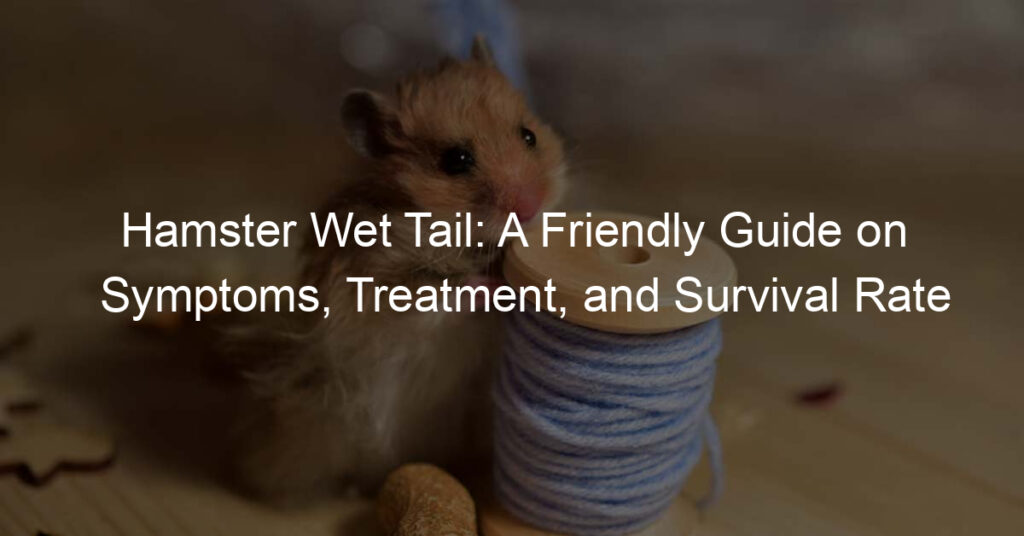A hamster wet tail is a severe and potentially fatal illness that affects hamsters, characterized by a constantly wet rear end, including the tail.
The condition, also known as proliferative ileitis or regional enteritis, occurs due to a bacterial infection.
Owners must be vigilant in monitoring their pets for signs of wet tails and act quickly, as early detection and treatment are crucial to improving a hamster’s chances of survival.
Understanding the causes of hamster wet tail, being able to recognize its symptoms, and knowing the appropriate treatment approaches are crucial for hamster owners.
Maintaining good hygiene and taking preventative measures can help reduce the risk of this illness.
Furthermore, being aware of the prognosis, survival rate, and potential complications associated with wet tail can help owners make informed decisions about their hamster’s care and well-being.
Key Takeaways
- Hamster wet tail is a serious, potentially fatal bacterial infection that requires early detection and treatment.
- Good hygiene and preventive measures can reduce the risk of wet tail in hamsters.
- Familiarity with symptoms, treatment approaches, and prognosis can help owners make informed decisions about their hamster’s care.
Understanding Hamster Wet Tail
Hamster wet tail, also known as wet tail disease, is a bacterial infection that primarily affects hamsters.
It is one of the most common illnesses that a hamster may experience during its lifetime and requires prompt attention from a veterinarian.
The bacteria responsible for wet tail in hamsters is called Lawsonia intracellularis. It leads to a condition known as proliferative ileitis, which causes inflammation in the hamster’s intestinal tract.
The infection takes a toll on the hamster’s digestive system, leading to severe dehydration and weakness.
Some key symptoms of a hamster wet tail include:
- Diarrhea, often with a foul smell
- Wet and dirty rear area
- Lethargy or excessive sleeping
- Loss of appetite
- Weight loss
- Folded ears
- Aggression, including biting their owner or other hamsters
It is essential to be vigilant about monitoring your hamster for these symptoms. If you suspect your hamster is suffering from a wet tail, it is crucial to consult a veterinarian as soon as possible.
Your vet may prescribe antibiotics as part of the treatment plan to help combat the infection.
Preventing a wet tail can involve maintaining proper hygiene and regularly cleaning your hamster’s living environment. Though a dirty cage is not the primary cause of a wet tail, a clean living space can help ensure your hamster’s overall health and reduce the risk of infection.
Unfortunately, hamster wet tail can be challenging to treat, and the survival rate may be low even with early intervention.
It is important to remember that a hamster showing symptoms of wet tail disease must receive medical attention to have any chance of recovery.
Stay informed and take care of your furry friend to ensure their well-being.
Causes of Wet Tail in Hamsters
Stress Factors
Wet tail in hamsters can be triggered by various stress factors. One common stressor is the introduction of a new hamster to the cage. This change can cause tension between the hamsters and lead to the development of wet tail.
Additionally, adjusting to a new environment, such as a change in the cage setup or the addition of toys, can also cause stress for the hamster. It is essential to keep an eye on your hamster’s stress levels to prevent the onset of a wet tail.
Bacterial Infections
Bacterial infections are another significant cause of wet tail in hamsters. The most common infectious agent responsible for this condition is Lawsonia intracellularis, a bacterium that causes inflammation in the gut of the hamster.
Infection can occur through direct contact with infected feces or bedding or by sharing cages, toys, and other items with an infected hamster.
To minimize the risk of bacterial infections, it is crucial to maintain a clean and hygienic environment for your furry friend.
Recognizing Symptoms of Wet Tail
Distinctive Signs
When taking care of hamsters, it is essential to recognize the symptoms of wet tail to ensure proper care and treatment.
Wet tail is a severe illness that can be fatal to hamsters, and it exhibits several distinctive symptoms, which include:
- Diarrhea: One of the primary signs of wet tail is diarrhea. When a hamster is suffering from a wet tail, they may have loose, watery stools, leading to the characteristic “wet tail” appearance.
- Odor: A strong, distinctive smell often accompanies a wet tail due to diarrhea and wetness near the hamster’s rear.
- Loss of appetite: Affected hamsters may exhibit a lack of appetite, resulting in weight loss.
- Sleeping and lethargy: Wet tail can cause hamsters to become lethargic and sleep more than usual. The hamster’s energy level may be notably lower, and they may seem less enthusiastic about things they once enjoyed.
- Hunched back: A hamster suffering from a wet tail may walk with a hunched back, indicating abdominal pain.
- Aggression: Wet tail may also cause a change in the hamster’s behavior, such as increased aggression, biting their owner or other hamsters.
- Dehydration: Dehydration is another potential symptom of wet tail, as affected hamsters lose essential fluids through diarrhea. Sunken eyes can indicate dehydration in hamsters.
Recognizing these symptoms is crucial to providing proper care and treatment for a hamster with a wet tail.
Early identification and intervention may increase the chances of survival and help your beloved pet recover more smoothly.
Treatment Approaches
When it comes to treating wet tail in hamsters, a combination of professional veterinary care and at-home measures can make a significant difference in their recovery process.
In this section, we will discuss the importance of vet consultations and antibiotics, as well as what you can do at home to help your hamster recover.
Vet and Antibiotics
The primary treatment for wet tail is a course of antibiotics prescribed by a veterinarian. If you suspect that your hamster has a wet tail, it is crucial to seek veterinary advice immediately, as the condition can be fatal if left untreated.
In addition to prescribing antibiotics, the vet may also provide guidance on how to manage your hamster’s symptoms and care for them during the recovery process.
At-Home Measures
While veterinary intervention is essential, there are also steps you can take at home to facilitate your hamster’s recovery from a wet tail.
These include maintaining proper hygiene, providing adequate hydration, and adjusting their diet.
Hygiene: Keep your hamster’s living environment clean by regularly changing their bedding, removing any soiled materials, and sanitizing their habitat. To gently clean your hamster’s wet tail area, use a cotton ball or Q-tip soaked in warm water, taking care not to cause discomfort.
Hydration: Ensuring that your hamster stays hydrated is crucial during their recovery. Make sure they have access to fresh, clean water at all times. If your hamster is not drinking enough water, you can try offering unflavored Pedialyte to encourage them to drink.
Diet: A temporary change in diet may help alleviate your hamster’s wet tail symptoms. Provide them with soft foods, such as mashed baby food, fresh fruit, and vegetables, to ease digestion. Avoid offering sugary and fatty items that may worsen the condition. Be sure to monitor your hamster’s appetite and consult your veterinarian if they refuse to eat.
In conclusion, treating wet tail in hamsters requires a combination of professional veterinary care and attentive at-home management.
By following your vet’s advice, maintaining a clean environment, and adapting your hamster’s diet and hydration during their recovery, you can significantly increase their chances of overcoming this serious condition.
Hamster Hygiene and Maintenance
Maintaining proper hygiene and cleanliness in a hamster’s environment is essential in preventing hamster illnesses like wet tail. A clean living space can significantly reduce the risk of harmful bacteria overgrowth, which is one of the known causes of this ailment.
Therefore, ensuring that your hamster’s cage and its contents are clean and sanitary is crucial for their overall health.
One of the primary steps in hamster maintenance is regularly cleaning the cage. This involves removing soiled bedding, fecal matter, and any leftover food.
A thorough cleaning routine should be done at least once a week, whereas removing feces and uneaten food should be done daily.
To avoid stressing your hamster, it’s best to use a pet-safe cleaner and water solution to clean the cage, as using harsh chemicals might cause unnecessary stress.
When cleaning, make sure to sanitize toys and accessories inside the cage as well. Hamsters are playful creatures and often come into contact with their toys.
Take care to wash these in warm, soapy water and rinse them thoroughly to remove any soap residue. If you are purchasing new toys from a pet store or pet shop, ensure they are of good quality and safe for use.
Keeping your hamster’s water source clean and uncontaminated is another essential aspect of maintaining proper hygiene. Make sure to clean, refill, and check the water bottle daily for any signs of mold or dirt.
Replace the water bottle if you notice cracks, leaks, or excessive buildup inside.
Lastly, monitoring your hamster’s behavior and appearance is an essential part of maintaining their health. If you notice any signs of illness, such as lethargy, loss of appetite, or symptoms related to a wet tail, it is best to consult with a veterinarian immediately.
Always remember that a clean, stress-free environment can significantly contribute to the prevention of contagious illnesses like wet tail, ensuring a healthier and happier life for your furry friend.
Prevention Strategies
Hamster wet tail, a severe illness that can be fatal to hamsters, can be prevented by maintaining a clean and stress-free environment for your furry friend.
Here are some friendly prevention strategies to help keep your hamster healthy:
- Maintain a clean living environment: Regularly clean your hamster’s cage, including their bedding and toys. Replace soiled bedding with fresh material to minimize the growth of bacteria that can cause a wet tail. Also, be sure to clean your hamster’s food and water dishes regularly.
- Provide a balanced diet: A proper diet plays a crucial role in keeping your hamster healthy and reducing the risk of a wet tail. Ensure your hamster receives a balanced and nutritionally complete food mix, avoiding treats high in sugar or high-water-content fruits and vegetables, which can lead to diarrhea and increase the risk of wet tail.
- Fresh and clean water: Make sure your hamster always has access to fresh, clean water. Regularly check their water bottle and replenish it as needed. Cleaning the water bottle frequently is essential in preventing the growth of bacteria.
- Minimize stress: Stress can weaken your hamster’s immune system, making them more susceptible to wet tail. Provide your hamster with a spacious and comfortable cage, along with hiding places and toys for stimulation. Avoid handling your hamster excessively, and if you have more than one hamster, avoid mixing them unless absolutely necessary.
- New hamster quarantine: When introducing a new hamster to your home, it’s essential to quarantine them for at least two weeks. This will allow you to monitor their health and prevent the spread of wet tail or other diseases to your existing hamster population.
By following these prevention strategies, you can help to create a friendly and healthy environment for your hamster, reducing the likelihood of wet tail and other illnesses.
Prognosis and Survival Rate
Wet tail is a serious and potentially fatal illness affecting hamsters. It’s crucial to identify and address the symptoms as soon as possible to increase the chances of recovery.
In this section, we will discuss the survival rate and recovery process for hamsters suffering from wet tail.
The survival rate is largely dependent on how quickly treatment is started. With prompt intervention and appropriate care, hamsters can recover from wet tail.
Regardless, if left untreated, the condition can quickly lead to dehydration, a decline in the hamster’s energy levels, and, ultimately, death.
To improve a hamster’s prognosis, it’s essential to monitor their behavior and overall health. Upon detecting signs of a wet tail, immediately consult a veterinarian.
They will likely prescribe antibiotics to combat the infection and provide guidance on supportive care to help the hamster through the recovery process.
Ensuring your hamster remains hydrated is of utmost importance during this time. Dehydration can worsen the condition and decrease the likelihood of survival.
Provide clean water and encourage your pet to drink. You may also need to offer electrolyte solutions as per your veterinarian’s recommendations.
Maintaining a clean and comfortable living environment is equally important for a recovering hamster. Regularly clean and sanitize their cage, keeping bedding fresh and stress levels to a minimum.
This aids in preventing the spread of the infection to other hamsters and supports the recovery process.
The survival rate for hamsters with wet tail is closely linked to the timeliness and adequacy of treatment. Prompt veterinary care, proper hydration, and a clean environment can significantly increase the chances of a full recovery.
Potential Complications
Wet tail is a severe illness in hamsters that can lead to a variety of complications if not treated promptly and effectively. The disease is contagious, which means it can spread easily among hamsters, especially when they live close to each other.
One of the critical aspects of handling a hamster with a wet tail is isolating the ill pet from other hamsters to prevent the dangerous spread of the disease.
A hamster with a wet tail might experience a range of symptoms that can worsen over time if left untreated. These symptoms include diarrhea, lethargy, a hunched back, loss of appetite, sunken eyes, and a discharge around the tail and anus.
Diarrhea, in particular, can lead to severe dehydration in the hamster, which is dangerous and can even be fatal if not addressed immediately.
Another potential complication is the hamster’s overall weakened state due to loss of appetite and lethargy. This can leave the pet vulnerable to other infections, causing the condition to become even more difficult to manage.
A hamster experiencing these symptoms needs proper care and attention to help them regain their strength and health.
A wet tail can cause immense discomfort and stress for the hamster. The discharge can lead to a foul odor, which can further distress the animal.
Additionally, the constant wetness around the tail and anus can cause skin irritation and inflammation, making the situation even more painful for the hamster.
Prompt diagnosis and treatment play a crucial role in preventing wet tail from leading to serious complications or even death.
If you suspect your hamster has a wet tail, it’s essential to consult a veterinarian as soon as possible, as they can provide appropriate antibiotics and advise on supportive care to increase the chances of recovery.
Potential complications of wet tail include contagiousness, diarrhea, dehydration, a weakened immune system, and physical discomfort.
Taking immediate action by consulting a veterinarian and providing proper care is critical to avoiding these complications and giving your hamster the best chance for a full recovery.
Conclusion
A hamster wet tail is a severe and potentially fatal condition that affects hamsters. This illness, also known as proliferative ileitis or regional enteritis, is characterized by a constantly wet rear end and tail due to the discharge coming from the anus.
Wet tail is caused by bacteria and is highly contagious, particularly among other hamsters.
Some of the symptoms of wet tail in hamsters include diarrhea, foul-smelling feces, lethargy, folded ears, and aggression. If left untreated, wet tail can be deadly, so it is crucial to monitor hamsters for these symptoms and seek veterinary assistance as soon as possible.
Treatment typically involves the use of antibiotics prescribed by a veterinarian.
Despite early detection and proper treatment, hamsters suffering from wet tail may still succumb to the illness. Therefore, prevention is vital to ensure a healthy environment for hamsters.
Maintaining a clean cage, monitoring the hamster’s diet, and providing a stress-free environment are essential steps to prevent wet tail.
In conclusion, hamster wet tail is a serious health concern that requires immediate attention, prevention, and proper care.
By being vigilant and informed, hamster owners can help protect their beloved pets from this potentially fatal illness and ensure their happiness and well-being.
Frequently Asked Questions
What are the early signs of wet tail in hamsters?
Hamsters with wet tail may exhibit a variety of symptoms in the early stages, such as diarrhea, a wet and matted rear end, lethargy, loss of appetite, and a hunched posture.
They may also show signs of aggression or have folded ears. Keeping an eye on your hamster’s behavior and physical appearance can help you detect wet tail early.
What treatments are available for hamsters with wet tail?
The primary treatment for hamsters with wet tail is antibiotics prescribed by a veterinarian. It is important to promptly consult a vet when you notice any symptoms of wet tail, as the condition can be fatal if left untreated.
In addition, make sure to maintain a clean and stress-free environment for your hamster to aid recovery.
How long can a hamster survive with a wet tail?
The survival rate of hamsters with wet tail depends on several factors, including how early the condition is diagnosed and how quickly treatment is administered.
In some cases, hamsters may succumb to wet tail within 24-48 hours if left untreated. However, prompt treatment can significantly increase the chances of recovery.
Is wet tail disease curable in hamsters?
Yes, wet tail in hamsters can be cured if it is diagnosed and treated promptly. Antibiotics prescribed by a veterinarian play a crucial role in the recovery process.
Nonetheless, it’s important to note that even with proper treatment, some hamsters may unfortunately still pass away due to the severity of the condition.
What causes wet tail in hamsters?
Wet tail is caused by a bacterial infection primarily linked to the bacterium Lawsonia intracellularis. The infection leads to diarrhea and dehydration, which can be life-threatening for your hamster.
Wet tail can be triggered by stress, poor sanitation in the cage, and other underlying health problems.
Can a hamster recover from a wet tail?
Yes, hamsters can recover from wet tail if treated promptly and correctly. While a wet tail can be fatal, proper care from a veterinarian, antibiotics, and a clean environment can improve the chances of your hamster’s survival.
It’s essential to monitor your hamster’s health closely and seek veterinary assistance as soon as any symptoms are observed.








